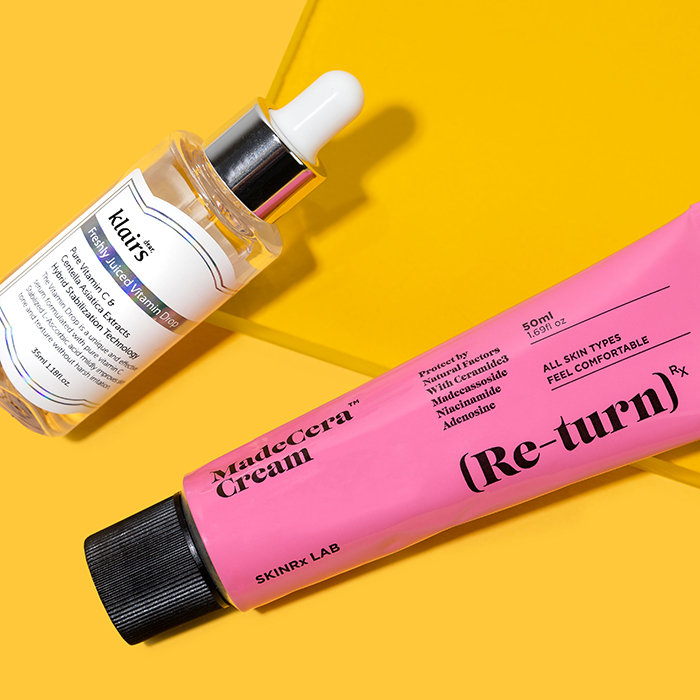At The Klog, we often get asked about the do’s and dont’s of mixing ingredients. When it comes to strong ingredients like vitamin C, retinol, and acids, we usually suggest erring on the side of caution since they can be sensitizing on their own, let alone together. However, skin care isn’t always black and white. For some, like longtime users of certain active ingredients or those with specific skin types, mixing actives can not only be safe but beneficial (we still recommend patch testing first!). Here, a scientist at a major beauty company (check out her Instagram account devoted to skin care education here!) discusses three types of vitamin C cocktails.
Vitamin C a.k.a. L-ascorbic acid is one of the most popular skin care ingredients of the moment and it’s not surprising! The benefits of L-ascorbic acid are plenty. It’s backed by decades of research and has proved to be one of the most effective antioxidants that can protect skin against free radical damage and various environmental stressors. The result of using vitamin C on a consistent basis is a brighter, overall more radiant skin tone.
However, one major confusion among consumers in regards to incorporating this ingredient into their skin care routines is what other actives they can mix it with. To clear things up, understanding the chemistry behind vitamin C is key.
Vitamin C + Niacinamide
Niacinamide is a base and vitamin C is an acid. So in a perfect world of chemistry, an acid and a base should neutralize in solution and cancel each other out right? Not always! It depends on the type of solution, the pH, temperature, and other factors.
RELATED: The Best Skin Brightening Ingredients
The reality is that niacinamide is extremely stable. It takes A LOT of energy (called activation energy) for it to react with anything. This means it won’t react with vitamin C, so there is no risk of neutralization. Not to mention, in a cosmetic formulation there are many other ingredients that are at play. The chances of niacinamide and vitamin C interacting with each other and forming a bond that cancels each other out are quite slim. This means you can use niacinamide and vitamin C together without any problem.
Each of these ingredients on their own can help address dark spots and uneven skin tone, and when used together, they will still work just as effectively and sometimes even better.
Vitamin C + Alpha and Beta Hydroxy Acids
Alpha hydroxy acids (AHAs) like glycolic acid or beta hydroxy acids (BHAs) like salicylic acid can be used first to “prep” the skin. This can be in a toner or serum form. Since alpha and beta hydroxy acids are usually acidic, the application creates the perfect environment on your skin for vitamin C.
RELATED: The Correct Way to Layer Acids In Your Routine
Naturally, the next step would be using vitamin C, usually in a serum form. Both alpha hydroxy acids and vitamin C work well in a low pH so the effects of each ingredient will be additive. In fact, studies have shown that chemical exfoliation with glycolic acid or lactic acid allows for better penetration of topical vitamin C. And using both ingredients in the same routine can help achieve a more even skin tone and texture.
Vitamin C + Retinol
Retinols usually work best in an acidic environment. This means if you use vitamin C, which is usually low pH and acidic, prior to using retinol, retinol will work very effectively. Both help with exfoliation and to improve overall skin texture. Studies have shown that using a product with 5% vitamin C (like the Klairs Freshly Juiced Vitamin C Serum) increased elastic fibers and showed a more uniform distribution of type I collagen bundles. This works nicely with retinol because it also stimulates collagen production! Together, one can expect to see a smoother, brighter and even skin texture.
Bottom Line
Just because you can mix two ingredients together doesn’t mean you should. The most important thing to remember is to use adequate sunscreen and to listen to your skin. Sensitive skin types may find that mixing two active ingredients can increase skin irritation. However, oily and combination skin types may experience no problems. It’s important to listen to your skin and to understand that skin care is an individual journey!
If you’re new to any of the ingredients mentioned above, click here to learn how to safely ease them into your routine.
